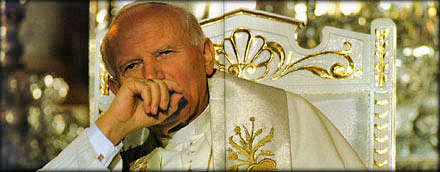
|
http://www.latimes.com/ February 09, 1996
Pope Preaches Message of Reconciliation Amid a Divided Church in El Salvador By Juanita Darling Times Staff Writer
Pope John Paul II arrived here Thursday with a message of reconciliation for a country recovering from war but found a deeply divided church hierarchy. A week before the pope's arrival, the Salvadoran bishops' conference led by Archbishop Fernando Saenz Lacalle fired the entire faculty of the country's main seminary, a stronghold of social activism. The archbishop's assistant, Msgr. Gregorio Rosa Chavez, acknowledged in a radio interview that this country's nine bishops are split over how outspoken the church should be on social issues. Rumors are rife that Rosa Chavez himself will be removed soon to a rural diocese. The upheaval contrasted sharply with the conciliatory theme of the papal visit, John Paul's last stop in Central America before his Latin American tour ends in Venezuela on Sunday. Coming four years after Salvadorans signed a peace agreement to end a 12-year civil war, the trip was designed to emphasize reconciliation, which has been Saenz Lacalle's theme since he was named archbishop last year.
"Today I can see that the seed sown in difficult moments, fertilized by the suffering and effort of an entire people, is bearing fruit of reconciliation and justice," John Paul said during a hot, crowded open-air Mass. Before he spoke, five pairs of worshipers, including a police officer and a former guerrilla, as well as a worker and an employer, placed offerings on the altar. The final and strongest symbol of rapprochement was the pope's meeting on the steps of the San Salvador cathedral, which was freshly painted off-white, with youths and church workers selected from parishes throughout the country. Through four decades of war, natural disaster and poverty, the church had remained a gray, concrete bulk covered by scaffolding, an unfinished monument to a nation divided against itself. Protesters were massacred on the cathedral steps in 1980 in the weeks leading up to the civil war. A 1986 earthquake, which killed about 1,500, cracked the cathedral walls. Throughout the war, dissidents on several occasions occupied the cathedral to seize the national stage. When the peace was signed in 1992, Salvadorans flocked to the cathedral to celebrate. "I praise God that I can be with you before this cathedral that is so closely tied to the pleasures and hopes of the Salvadoran people," the pope told 15,000 church workers gathered in the plaza outside the church. As he did during his 1983 visit, John Paul prayed privately at the tomb of Archbishop Oscar Romero, who was killed while celebrating Mass in 1980 and is buried in the cathedral crypt. A group of seminary students presented the pope with a letter requesting that he initiate canonization of Romero. Romero and his successor, Arturo Rivera Damas, who was archbishop during the war, are revered by the Salvadoran poor. However, many members of the military and upper class blame the churchmen's fiery defense of human rights for politicizing religion and deepening class conflict. Saenz Lacalle has been notably less outspoken on such issues than his predecessors. Business and government have contributed more than $2 million to the reconstruction of the cathedral since the papal visit was announced in October. That amount nearly equals all previous contributions for reconstruction since an earlier cathedral burned to the ground in 1951--proof of improved church relations with both the public and private sectors. |
| top |